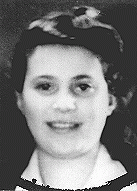
Dosia Szabszevicz
Born: October 30, 1932
Lodz, Poland
Dosia, her older sister and parents lived on her grandfather's estate in the town of Ozorkow, eight miles from Lodz. Dosia's parents were secular Jews. They spoke both Polish and Yiddish to each other, but only Polish to their children. Dosia's father worked as an accountant, and her mother was active in organizing charity events for several of Ozorkow's Jewish organizations.
1933-39: A few days after Germany invaded Poland in 1939, Dosia saw the Polish army retreat through Ozorkow, carrying their wounded on wagons and horses. Dosia and her family knew the war had started and that for Jews there was no choice but to hide. So the whole family gathered at her aunt's house. Looking out through the window blinds they saw the Germans arriving on horses, trucks and motorcycles. They were so happy and triumphant, those young soldiers.
1940-45: In 1942, after Dosia's whole family had been forced into the Ozorkow ghetto, Dosia, her mother, and her sister were transferred from there to the Lodz ghetto. When her mother came home from work one day feeling ill, they were afraid that, like many others in the ghetto, she'd die. Someone told Dosia that she'd get better by eating a lemon. So Dosia and her sister took half of their weekly bread ration--one loaf--and exchanged it for a lemon. They fed it to their mother, but soon afterwards, she died in Dosia's arms.
Dosia was deported to Auschwitz in 1944. She was transferred to a forced-labor camp, and from there to the Bergen-Belsen camp. After the war, Dosia immigrated to Palestine.